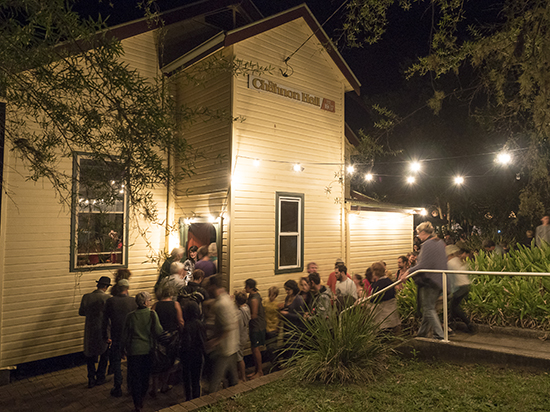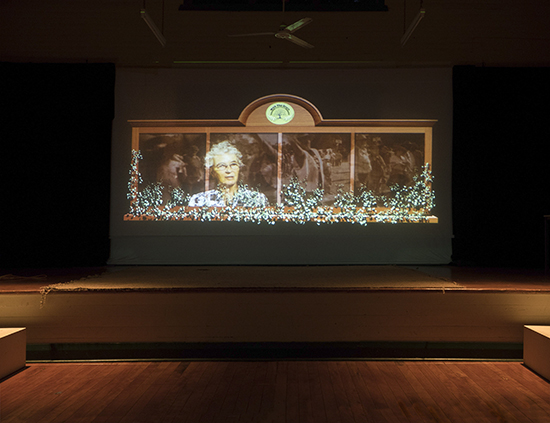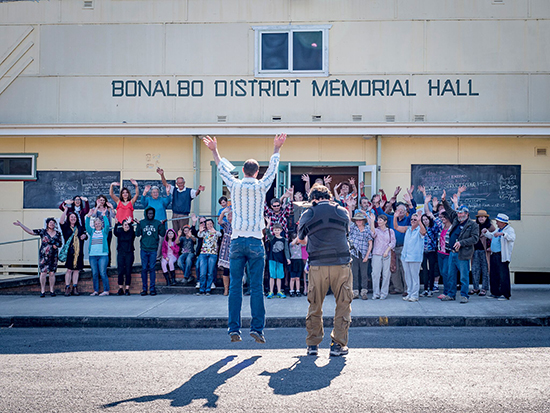Old halls, new lives
Barnaby Smith: Arts Northern Rivers, If These Halls Could Talk

The Channon Hall, If These Halls Could Talk
If it is empty and quiet, a visit to one of the many community halls that dot the landscape in the Northern Rivers region of NSW can be an eerie, lonely experience. The silence, the echo of your footsteps, the feeling that the place is vaguely haunted, the freezing temperatures in the cooler months—these buildings, totems of white settlement in the area on the back of the logging and farming industries, are nothing if not atmospheric.
Today many of these halls suffer a kind of identity crisis. No longer the essential hubs of community they once were, they host all kinds of events, including concerts, film nights, lectures, yoga classes, exhibitions, pop-up restaurants and the real earner, weddings.
They remain, however, fascinating spaces rich with creative possibility, something Arts Northern Rivers has recognised with its If These Halls Could Talk program. A selection of local and international artists is transforming seven of these halls with site-specific events responding to their unique individual histories and architectural character. Among these are elaborate theatrical productions from major institutions, such as Dreamland at Eureka Hall from Northern Rivers Performing Arts (NORPA) and a musical produced by Opera Queensland at Tumbulgum Hall.

Craig Walsh, With The Grain, If These Halls Could Talk
For other events, the halls are under the directorship of individual artists, and it is with these that a true sense of fellowship, of intimacy, is conjured in these buildings. Tweed Heads-based artist Craig Walsh, who has a background in working with regional communities to develop site-responsive pieces, was allocated The Channon Hall for his piece, With The Grain. On a moonlit Saturday night in September, a throng of delighted, dressed-up locals paraded through the village clutching lanterns on their way to the hall in which Walsh had installed a large video projection celebrating the town’s history accompanied by live music, acrobatics and dance. Walsh was inspired by The Channon’s history of collectivism, and specifically, how a town initially defined by the timber industry could develop a strong environmental conscience as the decades went by.
“My intention was to embrace what is a very significant history of collective action in response to environmental issues,” said Walsh. “My work explored the community’s relationship with timber over the course of the town’s history—what was once logged became treasured and protected. This defines the evolution of the town, as original settlers shared the space with the original environmentalists—these are the themes that emerged strongly from discussions with the community.”
Reflecting the philosophy of collectivism, Walsh invited the whole town to contribute, thus creating an occasion (or cause) towards which the entire populace could focus—a rare thing as communities become increasingly fragmented due to technology, economic change, gentrification and other factors.
“My role was to redefine this outpouring of creativity and knowledge into a live event which would express both the pride and core values guiding the town of The Channon. The work is not about an artist’s impression of the place but the artist reformatting what already exists into a new experience for all.”

Community participants, Bonnywood Rising, Grayson Cooke, Bonalbo District Hall
The idea of re-creating a hall’s golden days through a live event is also explored by multimedia artist Grayson Cooke with the more isolated (and very large) Bonalbo Hall. His piece, Bonnywood Rising, which takes place on 10 December, is a live cinema performance that, Cooke says, “harks back to silent cinema, where films were presented with live music, live narrators and sound effects.”
Cooke will present film footage shot months previously and augment it with an array of performed accompaniments designed to create a “dream machine to tease out the stories of the hall and community.”
Such an event could come across as an exercise in nostalgia. But Cooke, like Walsh, is invested in reinvigorating the space as a social focal point for the town’s current residents. Aside from its artistic merit, Bonnywood Rising is an opportunity for communion; in its creation alone, the project has engaged 100 participants.
“From talking to community members about their experiences in the hall,” says Cooke, “I found there was a real sense that a lot of the ‘life’ of the hall was in the past, that it had had its heyday and wasn’t used today anywhere near as much as it once was. I wanted to use this project as a corrective to that, to propose collective art-making as a way of refusing to be bound by history.” In fact, the entire If These Halls Could Talk concept can be seen as drawing these unique spaces into a contemporary context, albeit in decidedly old-fashioned ways.
If These Halls Could Talk runs until 17 December, details below.
–
Arts Northern Rivers, If These Halls Could Talk: NORPA, Dreamland, Eureka Hall, 23-26 Nov, 28 Nov-3 Dec, 5-10 Dec; Grayson Cooke, SCU, Bonnywood Rising, Bonalbo Hall, 10 Dec; Opera Queensland, Tumbulgum and the Countdown to Midnight at the First Supper Between Now and Forever, Tumbulgum Hall, Northern New South Wales, 16-17 Dec
RealTime issue #135 Oct-Nov 2016






